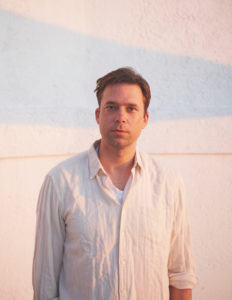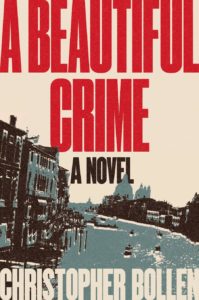Christopher Bollen has written a seductive and cold-blooded tale of deception with his latest book, A Beautiful Crime, published by Harper Books in late January. As he did in The Destroyers (2017), Orient (2015), and Lightning People (2012), Bollen displays an acumen for multidimensional characters and thrilling plots involving a volatile cat-and-mouse game.

His writing evokes comparisons to that of others — John Updike, Jonathan Franzen, Jeffrey Eugenides, and, as The Telegraph put it, he’s an “avowed disciple” of Agatha Christie. Bollen doesn’t exactly deny it.
“I love Christie’s plots,” Bollen told the Independent. “They are all so brilliant. But I don’t think I write like Agatha Christie. I don’t think she’s the best prose writer in the world. I’m not attacking one’s idols — I’m not really writing mystery novels in that kind of form.”
All the action in A Beautiful Crime takes place in Venice, where the book’s two antiheroes, Nick, a handsome young man from Ohio, and Clay, Nick’s African-American boyfriend, hatch a plan to scam an expat millionaire living in Italy. Clay has inherited an antique silver collection and half a grand palazzo once owned by his former partner, Freddy, who died of AIDS. The temptation to build on that temporal fortune pushes Clay and Nick to act unscrupulously.
If you are reminded of Patricia Highsmith’s The Talented Mr. Ripley, so were many critics. Bollen welcomes the comparison. “I love Ripley, and it’s a compliment,” he says. “When dealing with young men in Italy and a scam, you are stepping into Highsmith territory. I love her psychological fun houses.”

Yet there are differences: unlike Bollen’s characters, Tom Ripley is a sociopath without a conscience who goes on a crime spree through five Highsmith novels. “My characters are realistic, they have faults, but they are kind, considerate souls,” Bollen says. And yet: “Nick uses his innocence, good looks, and midwestern niceness, but he’s motivated by greed.”
Nick and Clay are based on Bollen’s own experiences. After graduating from Columbia in New York in 1998, he interned at the Peggy Guggenheim Collection in Venice. “I cut and pasted my memories from that time and threw them onto Clay,” he says. “It was such an eye-opener for me: I went to Venice as a kid, and the New Yorker darkness that I had been experiencing was shed overnight for the beauty of Venice.”
Bollen’s memories of growing up in the Midwest ended up in the character of Nick. “I based Nick on Daisy Miller, from the novel by Henry James. Daisy was a flirt who couldn’t be controlled. She was lovely but reckless and falls into danger.” Though Nick is the mastermind of all the young couple’s schemes, “because he is cute and because of his innocence, he is forgiven,” Bollen says. “He was a hard character to draw.”
Freddy, Clay’s former lover, was based on the late photographer David Armstrong, who used to show at the Bangs Street Gallery in Provincetown as well as the Whitney Museum of American Art. “Armstrong had the personality of a true bohemian eccentric,” Bollen says. “And Freddy was a person who was larger than life. He was an older man, which provided a vehicle to show the relationship between gay men of different generations — to show what is gained and what is lost by new freedoms and protections,” which are taken for granted by younger gay men.
Clay being black was a deliberate choice on Bollen’s part. “I felt I really couldn’t write effectively about the LGBTQ community today and only have a bunch of white guys running around Italy,” he says. “The gay world is much too diverse, and I wanted to represent that. I kept thinking about how Gore Vidal once said he chose ‘two all-American guys’ for the The City and the Pillar. Well, I did, too, for A Beautiful Crime, but the definition of what two all-American guys look like is very different now than what it was a century ago. Of course, I was aware of the difficulties and inherent problems of writing about a character of a different race, and it never left my mind. But it was too important to have a cast of characters that represent my experience with the gay community today in New York.”
Venice is also a character in the book, and Bollen succeeds at making the city come to life. He evokes images of the Venetian lagoon as people walk and get lost in the streets and alleys, ride boats in the canals, and luxuriate in the palazzi. “Venice, like Freddy, is bohemian, and it’s dying — it’s disappearing right before our very eyes,” Bollen says. “It’s like we are losing some great unicorn.”
Bollen lives in New York City, and in-between writing novels, he also writes about art and culture for Artforum and The New York Times and has just finished a true-crime story for Vanity Fair. “I love writing for magazines,” he says. “Fiction can be very insular and a little narcissistic. Writing about other people and places allows me to step away from my own desk and get out in the world and learn about all sorts of careers and artifacts and lives I’d never get to witness otherwise. And some of those details find their way back into my books.”



